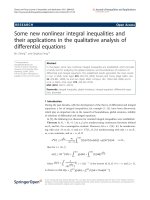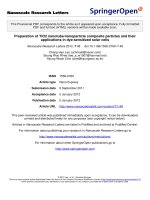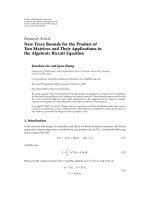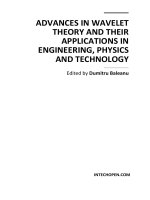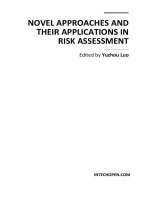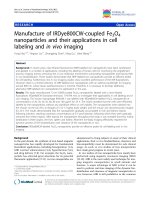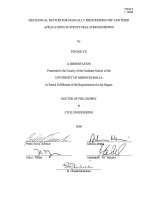Axisymmetric and three dimensional lattice boltzmann models and their applications in fluid flows
Bạn đang xem bản rút gọn của tài liệu. Xem và tải ngay bản đầy đủ của tài liệu tại đây (8.02 MB, 226 trang )
AXISYMMETRIC AND THREE-DIMENSIONAL
LATTICE BOLTZMANN MODELS AND THEIR
APPLICATIONS IN FLUID FLOWS
HUANG HAIBO
(B.Eng., University of Science and Technology of China,
M. Eng., Chinese Academy of Sciences, Beijing,China)
A THESIS SUBMITTED
FOR THE DEGREE OF DOCTOR OF PHILOSOPHY
DEPARTMENT OF MECHANICAL ENGINEERING
NATIONAL UNIVERSITY OF SINGAPORE
2006
i
ACKNOWLEDGEMENTS
I would like to express my sincere gratitude to my supervisors, Associate
Professor T. S. Lee and Professor C. Shu for their support, encouragement and
guidance on my research and thesis work.
Many people who are important in my life have stood behind me throughout
this work. I am deeply grateful to my wife, Chaoling and every member of my
family, my parents and my sisters, for their love and their confidence in me. Also I
thank my friends Dr. Xing Xiuqing, Dr. Tang Gongyue for their encouragement
and help in these years.
In addition, I will give my thanks to Dr. Peng Yan, Dr. Liao Wei, Cheng
Yongpan, Zheng JianGuo, Xia Huanming, Wang Xiaoyong, Xu Zhifeng and other
colleagues in Fluid Mechanics who helped me a lot during the period of my
research.
Finally, I am grateful to the National University of Singapore for granting me
research scholarship and precious opportunity to pursue a Doctor of Philosophy
degree.
ii
TABLE OF CONTENTS
ACKNOWLEDGEMENTS I
TABLE OF CONTENTS II
SUMMARY VIII
LIST OF TABLES X
LIST OF FIGURES XII
NOMENCLATURE XVIII
CHAPTER 1 INTRODUCTION & LITERATURE REVIEW 1
1.1 Background 1
1.2 Axisymmetric LBM 3
1.3 Axisymmetric and Three-dimensional LBM Applications 5
1.3.1 Study of Blood Flow 5
1.3.2 Taylor-Couette Flow and Melt Flow in Czochralski Crystal Growth 10
1.3.3 Study of Gas Slip Flow in Microtubes 12
1.4 Objectives and Significance of the Study 14
1.5 Outline of Thesis 15
CHAPTER 2 LATTICE BOLTZMANN METHOD 18
2.1 Introduction 18
iii
2.2 Continuum Boltzmann Equation and Bhatnagar- Gross-Krook Approximation
19
2.3 Formulation of the Lattice Boltzmann Method 20
2.3.1 Lattice Boltzmann Equation 20
2.3.2 From the Continuum Boltzmann Equation to LBE 21
2.3.3 Equilibrium Distribution 22
2.3.4 Discrete Velocity Models 23
2.4 From LBE to the Navier-Stokes Equation 25
2.4.1 Mass Conservation 27
2.4.2 Momentum Conservation 27
2.5 Incompressible LBM 29
2.6 Thermal LBE 30
2.7 Boundary Conditions 32
2.7.1 Bounce-back Boundary Condition 33
2.7.2 Curved Wall Non-slip Boundary Condition 33
2.7.3 Inlet/Outlet Boundary Condition 36
2.8 Multi-block Strategy 37
CHAPTER 3 AXISYMMETRIC AND 3D LATTICE BOLTZMANN
iv
MODELS 47
3.1 Source Term in LBE 47
3.2 Axisymmetric LBE 48
3.2.1 Incompressible NS Equation in Cylindrical Coordinates 49
3.2.2 Source Terms for Axisymmetric D2Q9 Model 50
3.2.3 Other Choices of the Source Terms for Axisymmetric D2Q9 Models 55
3.2.4 Theoretical Difference between Present and Previous Models 56
3.2.5 Axisymmetric Boundary Condition 58
3.3 Three-dimensional Incompressible LBE 60
3.4 Three-dimensional Incompressible Thermal LBE 61
CHAPTER 4 EVALUATION OF AXISYMMETRIC AND 3D LATTICE
BOLTZMANN MODELS 64
4.1 Implementation of the Axisymmetric Models 64
4.2 Steady Flow through Constricted Tubes 65
4.3 Pulsatile Flow in Tube (3D Womersley Flow) 69
4.3.1 Convergence Criterion and Spatial Accuracy 71
4.3.2 Validation by Cases with Different Womersley Number 73
4.3.3 Comparison of Schemes to Implement Pressure Gradient 75
v
4.3.4 Compressibility Effect and Comparison with Halliday’s Model 76
4.3.5 Comparison with 3D LBM: 77
4.4 Flow over an Axisymmetrical Sphere Placed in a 3D Circular Tube 78
4.5 Test of Multi-block Strategy by 2D Driven Cavity Flows 79
4.6 3D Flow through Axisymmetric Constricted Tubes 81
4.7 Three-dimensional Driven Cavity Flow 85
4.8 Multi-Block for 3D Flow through Stenotic Vessels 89
4.9 Summary 91
CHAPTER 5 BLOOD FLOW THROUGH CONSTRICTED TUBES 113
5.1 Steady and Pulsatile Flows in Axisymmetric Constricted Tubes 113
5.1.1 Steady Flows in Constricted Tubes 113
5.1.2 Pulsatile Flows in Constricted Tubes 116
5.2 3D Steady Viscous Flow through an Asymmetric Stenosed Tube 120
5.3 Steady and Unsteady Flows in an Elastic Tube 122
5.4 Summary 126
CHAPTER 6 LBM FOR SIMULATION OF AXISYMMETRIC FLOWS
WITH SWIRL 137
6.1 Hybrid Axisymmetric LBM and Finite Difference Method 137
vi
6.1.1 Boundary Conditions 139
6.2 Taylor-Couette flows 139
6.3 Flows in Czochralski Crystal Growth 141
6.4 Numerical Stability Comparison for Axisymmetric lattice Boltzmann Models
146
6.5 Summary 148
CHAPTER 7 GAS SLIP FLOW IN LONG MICRO-TUBES 155
7.1 Compressible NS Equation and Axisymmetric LBM 155
7.1.1 Knudsen Number and Boundary Condition 157
7.2 Analytical Solutions for Micro-tube Flow 159
7.3 Numerical Results of Micro-tube Flow 160
7.3.1 Distributions of Pressure and Velocity 160
7.3.2 Mass Flow Rate and Normalized Friction Constant 163
7.3.3 Comparison with DSMC 164
7.4 Summary 166
CHAPTER 8 EXTENDED APPLICATION OF LBM 172
8.1 Thermal Curved Wall Boundary Condition 172
8.2 Validation of the Thermal Curved Wall Boundary Condition 175
vii
8.3 Natural Convection in a Square Cavity 176
8.4 Natural Convection in a Concentric Annulus between an Outer Square
Cylinder and an Inner Circular Cylinder 178
8.5 Natural Convection in a 3D Cubical Cavity 179
8.6 Natural Convection from a Sphere Placed in the Center of a Cubical Enclosure
182
8.7 Summary 182
CHAPTER 9 CONCLUSIONS AND FUTURE WORK 192
REFERENCES 195
viii
SUMMARY
The lattice Boltzmann Method (LBM) has attracted significant interest in the
CFD community. Uniform grids in Cartesian coordinates are usually adopted in
the standard LBM. The axisymmetric flows which are described by
two-dimensional (2D) Navier-Stokes equations in cylindrical coordinates can be
solved by three-dimensional (3D) standard LBM but they are not able to be solved
by 2D standard LBM directly. To simulate the axisymmetric flows by using 2D
LBM, we suggest a general method to derive axisymmetric lattice Boltzmann
D2Q9 models in 2D coordinates.
Using the general method, three different axisymmetric lattice Boltzmann
D2Q9 model A, B and C were derived through inserting different source terms
into the 2D lattice Boltzmann equation (LBE). Through fully considering the
lattice effects in our derivation, all these models can mimic the 2D Navier-Stokes
equation in the cylindrical coordinates at microscopic level. In addition, to avoid
the singularity problem in simulations of Halliday et al. (2001), axisymmetric
boundary conditions were proposed.
The LBM results of steady flow and 3D Womersley flow in circular tubes
agree well with the FVM solutions and exact analytical solutions, which validated
our models. It is observed that the present models reduce the compressibility
effect shown in the study of Halliday et al. (2001) and is much more efficient than
the direct 3D LBM simulations.
Using the axisymmetric model and the multi-block strategy, the steady and
unsteady blood flows through constricted tubes and elastic vascular tubes were
simulated. Our 3D multi-block LBM solver which has second-order accuracy in
space was also used to study the blood flow through an asymmetric tube.
i
x
Besides the above application, an incompressible axisymmetric D2Q9 model
considering the swirling effect and buoyancy force was proposed to simulate the
benchmark problems for melt flows in Czochralski crystal growth. This is a hybrid
scheme with LBM for the axial and radial velocities and finite difference method
for the azimuthal velocity and the temperature. It is found the hybrid scheme can
give very accurate results. Compared with the previous model (Peng et al. 2003),
the present axisymmetric model seems more stable and provides a significant
advantage in the simulation of melt flow cases with high Reynolds number and
high Grashof number.
A revised axisymmetric D2Q9 model was also applied to investigate gaseous
slip flow with slight rarefaction through long microtubes. In the simulations of
microtube flows with Kn
o
in range (0.01, 0.1), our LBM results agree well with
analytical and experimental results. Our LBM is also found to be more accurate
and efficient than DSMC when the slip flow in microtube was simulated.
For the simulation of the heat and fluid flow with LBM, besides the above
hybrid scheme, it can also be solved by a double-population thermal lattice
Boltzmann equation (TLBE). A recent curved non-slip wall boundary treatment
for isothermal LBE (Guo, et al., 2002) was successfully extended to handle the 2D
and 3D thermal curved wall boundary for TLBE and proved to be of second-order
accuracy.
x
LIST OF TABLES
Table 2.1 Main parameters of popular 2D and 3D discrete velocity models 43
Table 4.1 Parameters for simulations of cases α=7.93 and α=3.17 when N
r
=20 .93
Table 4.2 The overall average error <ξ> comparison for two schemes to implement
the pressure gradient 93
Table 4.3 Mean density fluctuation 93
Table 4.4 The error of velocity field in 3D womersley flow 93
Table 4.5 Comparison of CPU time and error between two lattice BGK model for
3D womersley flow 94
Table 4.6 Vortex Centers, Stream function and Location for Multi-block scheme 94
Table 4.7 Comparison of CPU times in minutes to get 3 order of residual reduction
for steady flow through constricted tube (Re=10) (number in parentheses is the
number of steps) 94
Table 4.8 The number of Lattices for block A,B,C,D and range in x,y,z direction 95
Table 4.9 The position of the center of the primary vortices in plane z=H/2 95
Table 6.1 The maximum stream function in x-r plane for Taylor-Couette flow (grid
20×76) 149
Table 6.2 Comparison of CPU time for hybrid scheme and FVM simulation of
Taylor-Couette flow (Re=100, grid 30×114) 149
Table 6.3 Grid independence test for Case A2, Gr=0, Re
x
=10
3
, Re
c
=0 149
Table 6.4 Some results for the test cases by the hybrid scheme and QUICK* 150
Table 6.5 Numerical stability comparison for case A1 151
Table 7.1 Simulated diameter of microtubes for different gas flow (Kn
o
=0.013)167
Table 7.2 Efficiency and accuracy comparison (LBM and DSMC) (Kn
o
=0.0134,
Pr=2.5) 167
Table 8.1 Grid-dependence study for the natural convection in a square cavity at
Ra=10
4
, ∆=0 184
Table 8.2 Numerical results for cases with ∆=0.5, Ra=10
3
-10
6
184
Table 8.3 Numerical results for Ra=10
4
with mesh size 103×103 and different ∆
184
Table 8.4 The maximum stream function ψ
max
and the average Nusselt number Nu
a
xi
184
Table 8.5 Representative field values in the symmetric plane (y=0.5L) for 3D nature
convection in cubical cavity with ∆=0.0, Ra=10
3
-10
5
185
xi
i
LIST OF FIGURES
Figure 2.1 Streaming and collision steps in one time step 43
Figure 2.2 Discrete velocity sets {e
i
} for D2Q9, D2Q7, D3Q19 and D3Q15 models
44
Figure 2.3 The bounce back (a), half-way bounce back (b) and specular reflection (c)
schemes 44
Figure 2.4 curved boundary geometry and lattice nodes. Open circles (○) are wall
nodes and open squares (□) are the fluid nodes. The disks (●) are the nodes in
physical boundary. Solid squares (■) are located in the fluid region but not on
grid nodes. The thin solid lines are the grid lines. The thick arrows represent
the trajectory of a particle interacting with the wall. 45
Figure 2.5 Curved wall boundary treatment of Guo et al. (2002a) 45
Figure 2.6 Interface structure between fine and coarse blocks 46
Figure 2.7 Bilinear spatial interpolation scheme 46
Figure 3.1 The computational domain for axisymmetric flow simulation 63
Figure 4.1 Geometry of constricted tubes 95
Figure 4.2 Velocity profiles in different position in case of S
0
=D, Re=50 96
Figure 4.3 Relative error η in simulations with model A,B and C 96
Figure 4.4 Velocity profiles in different position in case of S
0
=D, Re=100 97
Figure 4.5 Streamlines and shear stress contours for case of S
0
=D, Re=100 97
Figure 4.6 Wall vorticity for case of S
0
=D, Re=100 97
Figure 4.7 Scheme to obtain wall shear stress and wall vorticity, the open square and
circle represents the lattice node outside and inside of the boundary
respectively. The near-wall fluid lattices are represented by filled circle. 98
Figure 4.8 Results obtained from model of Halliday et al. for case of S
0
=D, Re=10
98
Figure 4.9 Maximum velocity in the axis of tube and the phase lag as a function of
Womersley number 99
Figure 4.10 The global error <ξ> as a function of the pipe radius N
r
for α=7.93 and
α=3.17 99
Figure 4.11 The overall accuracy of extrapolation wall boundary condition
combining with axisymmetric extrapolation scheme 100
xiii
Figure 4.12 Profiles of decreasing and increasing velocities along the radius of a
tube for α=7.93, T=1200, Re=1200, τ=0.6, at t=nT/16 (n=0,…,15) (U
c
=1.0,
actually U
max
~0.07) 100
Figure 4.13 Profiles of velocities along the radius of a tube for α=1.37, T=4000,
Re=1.2, τ=1.5, at t=nT/16 (n=0,…,15) (U
c
=0.01) 101
Figure 4.14 Profiles of velocities along the radius of a tube for α=24.56, T=1000,
Re=1920, τ=0.7, at t=nT/16 (n=0,…,15) (U
c
=0.8, actually U
max
~0.0056) 101
Figure 4.15 Shear stress in a oscillatory tube flow for case α=7.93, T=1200,
Re=1200, τ=0.6, at t=nT/16 (n=0,…,15) 102
Figure 4.16 Geometry of flow over an axisymmetrical sphere placed in a 3D
circular tube 102
Figure 4.17 Streamlines for flows over an axisymmetrical sphere placed in a 3D
circular tube at Re=50, 100 and 150 103
Figure 4.18 Velocity profiles in different position for flows over an axisymmetrical
sphere placed in a 3D circular tube (a) Re=50, (b) Re=100 103
Figure 4.19 Velocity (a) u
x
, (b) u
r
profiles in different position for flow over an
axisymmetrical sphere placed in a 3D circular tube Re=150 104
Figure 4.20 Pressure contours for Re=400 (a) single-block case with a grid 67×67
and (b) two-block case with a upper fine grid 133×37 and a lower coarse grid
67×50 104
Figure 4.21 Vorticity contours for Re=400 (a) single-block (67×67) case and (b)
two-block case (a upper fine grid 133×37 and a lower coarse grid grid 67×50 )
105
Figure 4.22 Stream function for Re=400 (a) single-block (67×67) case and (b)
two-block case (a upper fine grid 133×37 and a lower coarse grid grid 67×50 )
105
Figure 4.23 Spatial convergence rate for Re=400. The errors E1 and E2 are
calculated relative to results obtained on a 259×259 grid. (a) Slope of linear fit
of E1 (two-block case) is m=-2.21±0.16. Slope of linear fit of E1 (single-block
case) is m=-2.12±0.38. (b) Slope of linear fit of E2 (two-block case) is
m=-2.09±0.18. Slope of linear fit of E2 (single-block case) is m=-1.76±0.20.
106
Figure 4.24 Three-dimensional geometry of the stenosis in 3D Cartesian
coordinates 106
Figure 4.25 u velocities in the 8 planes were investigated for asymmetry 106
Figure 4.26 Solutions of 3D LBM and FVM (Re= 10) 107
Figure 4.27 Axial and radial velocity profiles in a 3D constricted tube (Re=100)
xiv
107
Figure 4.28 Geometry and multi-block strategy of 3D driven cavity flow 107
Figure 4.29 Comparison of u
x
profiles of the LBM multi-block case and
single-block case with a Navier–Stokes (NS) solution (Salom 1999) at x/H
=z/H =0.5 for Re=400 in a 3D lid-driven cavity flow 108
Figure 4.30 Comparison of u
y
profiles of LBM multi-block case and single-block
case with a NS solution (Salom 1999) at y/H =z/H =0.5 for Re=400 in a 3D
lid-driven cavity flow 108
Figure 4.31 A pressure contour obtained from the single 65
3
block solution 109
Figure 4.32 A pressure contour obtained from the multi-block solution 109
Figure 4.33 Exemplary particle paths of the steady solution at Re = 400. Particles
pass through the downstream secondary eddy region 110
Figure 4.34 The pressure contours on the interface between block B and C 110
Figure 4.35 Mass and momentum fluxes contours on the interface between block B
and C 111
Figure 4.36 2D projection of the discretized domain and the boundary nodes
(denoted by open circle) on the yz plane (D=16 coarse lattice units) 111
Figure 4.37 The multi-block strategy for a 3D constricted tube (xy plane) 112
Figure 4.38 The velocity component u
x
and u
y
profile along a diameter in xy plane at
x=0.5D, D and 2D 112
Figure 4.39 Exemplary particle paths of the steady solution at Re = 50. 112
Figure 5.1 Blood flow through (a) 64%, (b) 75%, (c) 84% stenosis (S
0
=D, Re=50)
127
Figure 5.2 Wall vorticity along the constricted tubes 127
Figure 5.3 Velocity profiles in different position in case of S
0
=D, Re=200 128
Figure 5.4 Velocity profiles in different position in case of S
0
=D, Re=400 128
Figure 5.5 Geometry and mesh of constricted tubes 128
Figure 5.6 Streamlines and shear tress contours for constriction spacings L/D=1,2,3
(Re=10) 129
Figure 5.7 Streamlines and shear stress contours for constriction spacings
L/D=1,2,3 (Re=50) 129
Figure 5.8 Streamlines and shear stress contours for constriction spacings
L/D=1,2,3 (Re=300) 130
xv
Figure 5.9 Variation of axial velocity on axis for different constriction spacings130
Figure 5.10 Variation of wall vorticity for different constriction spacings 131
Figure 5.11 Inlet velocity profiles based on the Womersley solution. (a) Temporal
variation of inlet volume flux. (b) Velocity profiles for α=4. (c) Velocity
profiles for α=8 131
Figure 5.12 The streamlines (above the axis) and vorticity contours (under the axis
area) in the constricted tube for Re=200, St=0.32 at t=nT/10, n= 1,3,5,7,9 .132
Figure 5.13 Wall vorticity obtained by LBM and FVM at t=nT/10, n= 1,2,3,4,5 for
pulsatile flow through a constricted tube 132
Figure 5.14 Wall vorticity obtained by LBM and FVM at t=nT/10, n= 6,7,8,9,10 for
pulsatile flow through a constricted tube 133
Figure 5.15 Geometry of the stenosis model 133
Figure 5.16 Streamline of flows though 3D asymmetric stenosis (a) Re=100, (b)
Re=200, (c) Re=500 134
Figure 5.17 Wall shear stress along axial position (53% 3D asymmetric stenosis) (a)
Re=100, (b) Re=200, (c) Re=500 134
Figure 5.18 Illustration of a moving boundary with velocity u
w
. The open circles (○)
and square (□) denote the non-fluid and fluid nodes, respectively. The filled
squares denote the nodes becoming fluid nodes from the non-fluid nodes after
one time step 135
Figure 5.19 Numerical and analytical solution for (a) radius in an elastic tube, (b)
pressure on inner elastic tube 135
Figure 5.20 Variation of the radius at x = 40 after the walls are released at t=1000 .
(a) steady flow on a 100×13 lattice (Re = 43.4); (b) pulsatile flow on a 100×13
lattice with T = 2000 (α=2.06) 136
Figure 5.21 Variation of radius in an elastic tube at t=nT+(k/10)T during a period
(pulsatile flow on a 100×13 lattice with T = 2000, α=2.06) 136
Figure 6.1 Geometry of Taylor-Couette flow and boundary conditions 151
Figure 6.2 The contour of stream function, pressure and vorticity for case Re=150
with grid 20×76 152
Figure 6.3 Convergence history for FLUENT and the hybrid scheme (LBM+FD)
152
Figure 6.4 The momentum and thermal boundary conditions of melt flow in
Czochralski crystal growth 153
Figure 6.5 Streamlines and temperature contours of case A2, Gr=0, Re
x
=10
3
, Re
c
=0
xvi
153
Figure 6.6 Streamlines and temperature contours of case B2, Gr=0, Re
x
=10
3
,
Re
c
=-250 154
Figure 6.7 Streamlines and temperature contours of case C2, Gr=10
6
, Re
x
=0, Re
c
=0
154
Figure 6.8 Streamlines and temperature contours of case D2, Gr=10
5
, Re
x
=10
2
,
Re
c
=0 154
Figure 7.1 Axial-velocity distributions in the tube 167
Figure 7.2 Radial-velocity distributions along the tube 167
Figure 7.3 Pressure distribution along the tube for different Pr (Kn
o
=0.1) 168
Figure 7.4 Pressure distribution along the tube for different Knudsen number (Pr=2)
168
Figure 7.5 Local Kn distribution along the tube for different Kn
o
(Pr=2) 169
Figure 7.6 Slip velocity in wall along the tube for different Kn
o
(Pr=2) 169
Figure 7.7 Average axial velocity U
av
along the tube for different Kn
o
(Pr=2) 170
Figure 7.8 Mass flow rate normalized to non-slip mass flow rate as a function of Pr
at Kn
o
=0.1 170
Figure 7.9 Normalized friction constant C
*
of gas flow in microtube as a function of
Re (Kn
o
=0.013) 171
Figure 7.10 Velocity profiles at x/L=0.375 obtained by analytical solution, LBM
and DSMC 171
Figure 8.1 Curved boundary and lattice nodes (open circle is wall nodes, open
square is fluid nodes, filled circle is the physical boundary nodes in the link of
fluid node and wall node) 185
Figure 8.2 Temperature profiles of the Couette flow at Re=10 with difference value
of the radius ratio 186
Figure 8.3 Temperature relative global errors versus the radius of the inner cylinder
in the Couette flow. (m is the slope of linear fitting line) 186
Figure 8.4 Boundary condition and geometry of natural convection in a square
cavity (N=13) 187
Figure 8.5 Streamlines of natural convection at Ra=10
3
,10
4
,10
5
,10
6
for cases ∆=0.5
187
Figure 8.6 Isotherms of natural convection at Ra=10
3
,10
4
,10
5
,10
6
for cases ∆=0.5
188
xvii
Figure 8.7 Streamlines of nature convection in a concentric annulus at
Ra=10
4
,5×10
4
,10
5
. 188
Figure 8.8 Isotherms of nature convection in a concentric annulus at
Ra=10
4
,5×10
4
,10
5
, the temperatures of inner cylinder and outer square are fix
as 2.5, 1.5 respectively. 189
Figure 8.9 Configuration of natural convection in a 3D cubical cavity 189
Figure 8.10 3D isotherms for the natural convection in a cubical cavity at Ra=10
4
(left) and10
5
(right). 190
Figure 8.11 3D streamlines for the natural convection in a cubical cavity at Ra=10
4
(left) and 10
5
(right). 190
Figure 8.12 3D isotherms for the natural convection from a sphere placed in the
center of a cubical enclosure at Ra=10
4
(left) and 10
5
(right) 191
Figure 8.13 3D streamlines for the natural convection from a sphere placed in the
center of a cubical enclosure at Ra=10
4
(left) and 10
5
(right) 191
xviii
NOMENCLATURE
Roman letters
A
B
α
C
αβ
c
c
s
e
i
E
f
i
f
i
+
F
α
g
i
g,g
0
Gr
Kn
M
M
max
N
r
Nu
p
p*
Pr
Pr
Re
r
R
St
S
i
t
T
T
U
max
U
c
u
u
x
u
r
u
α
x
function of body force in NS equation
function of body force in NS equation
function of body force in NS equation
velocity δ
x
/δ
t
the speed of sound
the particle velocity vector along direction i
some additional source terms in NS equation
the particle distribution function
distribution function after collision
body force in NS equation, α can represent x or r
the thermal energy density distribution function
gravitational acceleration
Grashof number
Knudsen number
Mach number
U
max
/c
s
number of lattice nodes in radius
Nusselt number
pressure
the maximum amplitude of the oscillatory pressure gradient
Prandtl number (except Chapter 7)
ratio of inlet and outlet pressure (Chapter 7)
Reynolds number
radius or radial coordinate
the radius of the circular pipe
Strouhal number of Womersley flow
source term added into lattice Boltzmann equation
time
temperature
sampling period in unsteady periodic flow (Chapter 4)
the maximum velocity appear in tube axis during a sampling
period
the characteristic velocity, which is equal to (α→0) or much
larger than (α »1) U
max
(Chapter 4)
fluid velocity vector
x component of the velocity
r component of the velocity
α component of the velocity, α can represent x or r
spatial position vector
Greek letters
α
β
0
δ
αβ
Womersley number (Chapter 4)
the thermal expansion coefficient
Kronecker symbol
xi
x
δ
x
δ
t
or δt
θ
<θ>
λ
ν
ξ
<ξ>
ρ
0
ρ
σ
τ
∆
ψ
ω
ω
i
Ω
∂
t
∂
α
lattice space size
time step
velocity error
overall θ averaged over a sampling period
the mean free path of gas
the kinetic viscosity of fluid
velocity error
overall ξ averaged over a sampling period
approximately constant density of incompressible fluid
fluid density
shear stress
the dimensionless relaxation time constant
the mean density fluctuation (Chapter 4)
stream function
angular frequency of Womersley flow
weight coefficients for the equilibrium distribution function
angular velocity
partial time derivative
partial space derivative, α can represent x or r
Superscripts
eq
ne
n
+
f
c
local equilibrium, zeroth order
non-equilibrium part
nth order of Chapman-Enskog series expansion
post-collision status
fine grid
coarse grid
Subscripts
i
α, β
x
r
o
the component in direction e
i
axial coordinate x or radial coordinate r
axial coordinate x
radial coordinate r
parameter at outlet (Chapter 7)
Abbreviations
BGK
CFL
FD
FVM
LBE
LBM
LBGK
NS
TLBE
Bhatnagar-Gross-Krook
Courant-Friedrichs-Lewy
finite difference
finite volume method
lattice Boltzmann equation
lattice Boltzmann method
lattice BGK
Navier-Stokes
Thermal lattice Boltzmann equation
Chapter 1 Introduction & Literature Review
1
Chapter 1 Introduction & Literature Review
1.1 Background
Fluid flow phenomena are very common in our everyday life. The flow of
water in rivers, movement of air in the atmosphere, the ocean currents and the
blood flow in animal cardiovascular system are all the common fluid flow
phenomena. The systematical studies on fluid dynamics have been conducted
since the 18
th
century. The fluid dynamics theory such as Navier-Stokes (NS)
equation has been established to describe the fluid flow since the middle of the
19
th
century. However, the NS equation cannot be solved theoretically without
simplifications because till today the analytical solutions of the NS equation is
only applicable to several ideal cases. When modern computers appeared in the
1940’s, using the computers to solve the equation system and study the fluid
dynamics became possible. From the 1940’s to today, popular computational fluid
dynamics (CFD) methods such as finite difference method (FDM) and finite
volume method (FVM) have been developed to solve the Navier-Stokes equation
numerically. These CFD methods solve the NS equations directly and the macro
variables such as velocity and pressure can be obtained. It is also noticed that the
above NS equation is based on the continuity assumption at macroscopic level,
which means the macro variables are well defined in a infinite small point and
vary continuously from one point to another.
On the other hand, the fluid system can also be viewed at microscopic level
since fluid is composed of a huge number of atoms and molecules. Through
modeling the motion of individual molecule and interactions between molecules,
the behavior of fluid can also be simulated since the macroscopic variables (e.g.,
Chapter 1 Introduction & Literature Review
2
pressure and temperature) can be obtained through statistical sampling.
Sometimes, the molecular dynamics simulation is very necessary, for example,
when the molecular mean free path is comparable to the flow characteristic length
(e.g., in study of rarefied gas dynamics), the continuum assumption breaks down
and the common CFD method at macroscopic level is not available. However, this
microscopic computation needs much more computational time than the common
CFD method at macroscopic level since it has to simulate the motions of a huge
number of molecules. That is the main disadvantage of this method.
Besides viewing the flow system at the above macroscopic scale and
microscopic scale, one may also interested to view the system at an intermediate
scale: the mesoscopic scale. At this scale, the lattice gas cellular automata (LGCA)
was proposed to simulate fluid flows and other physical problems by Hardy,
Pomeau and de Pazzis in 1973. This model considered a much smaller number of
fluid ‘particles’ than molecular dynamics method because a fluid ‘particle’ is a
large group of molecules. On the other hand, the fluid ‘particle’ is still
considerably smaller than the smallest length scale of the simulation.
The LGCA model proposed by Hardy et al. (1973) conserves mass and
momentum but it does not yield the desired Navier-Stokes equation at the
macroscopic level. Later it is found that through a multiple-scale expansion, a
LGCA over a lattice with higher symmetry than that of Hardy et al. (1973) can
simulate the Navier-Stokes equation at the macroscopic level (Frisch et al., 1986).
Hence, the LGCA can also be viewed a non-direct solver for the Navier-Stokes
equation. However, the LGCA method suffers from some drawbacks such as
statistical noise and lack of Galilean invariance (Qian et al., 1992). To get rid of
above drawbacks, McNamara et al. (1988) proposed to model lattice gas with
Chapter 1 Introduction & Literature Review
3
Boltzmann equation. Hence, the LGCA method was further improved and
developed into lattice Boltzmann method (LBM) ( McNamara et al. 1988, Higuera
et al. 1989, Qian, et al, 1992).
Unlike traditional CFD methods (e.g., FDM and FVM), LBM is based on the
microscopic kinetic equation for the particle distribution function and from the
function, the macroscopic quantities can be obtained. The kinetic nature provides
LBM some merits. Firstly, it is easy to program. Since the simple collision step
and streaming step can recover the non-linear macroscopic advection terms,
basically, only a loop of the two simple steps is implemented in LBM programs.
Secondly, in LBM, the pressure satisfies a simple equation of state when simulate
the incompressible flow. Hence, it is not necessary to solve the Poission equation
by the iteration or relaxation methods as common CFD method when simulate the
incompressible flow. The explicit and non-iterative nature of LBM makes the
numerical method easy to parallelize (Chen et al. 1996).
Over the past two decades, the LBM has achieved great progress in fluid
dynamics studies (Chen and Doolen, 1998). The LBM can simulate the
incompressible flow (Succi et al., 1991, Hou and Zou, 1995) and compressible
flows (Alexander, 1992). The LBM has also been successfully applied to the
multi-phase flow (Grunau et al., 1993), immiscible fluids (Gunstensen et al.,
1991), flows through porous media (Chen et al., 1991) and turbulence flow (Benzi
and Succi, 1990, Teixeira, 1998).
1.2 Axisymmetric LBM
As we know, the lattice Boltzmann method simulates the fluid flows through
streaming and collision steps. In the streaming step, the post-collision distribution
Chapter 1 Introduction & Literature Review
4
function would stream to the nearby lattice nodes according to a certain lattice
velocity model. Since all lattice velocity models are regular and defined in the
Cartesian coordinates, the standard LBM is based on the Cartesian coordinate
system and essentially requires uniform lattice grid.
Hence, to simulate the axisymmetric flows which are two-dimensional or
quasi-three-dimensional problems in cylindrical coordinates, we may have to
carry out 3D simulation in 3D cubic lattices if we use the standard LBM. However,
3D simulations mean a large grid size. It is not so efficient to simulate an
axisymmetric swirling flow problem in that way.
To simulate the axisymmetric flow more efficiently, Halliday et al. (2001)
proposed an axisymmetric D2Q9 model for the steady axisymmetric flow
problems and it seems successful for simulation steady flow in straight tube with
low Reynolds number (i.e., Re<100). The main idea of the D2Q9 model is
inserting several spatial and velocity-dependent source terms into the adjusted
evaluation equation for the lattice fluid’s momentum distribution. That is very
similar to the idea of inserting source terms to Navier-Stokes equation to simulate
some kind of flow problems in the conventional CFD methods (e.g., when
simulate multiphase flow, the surface tension effect is usually incorporated into
the NS equation).
However, Halliday et al. (2001) did not fully consider the lattice effects in
their derivation and some important terms are not considered in their derivation.
Hence, the model cannot recover the NS equation at macroscopic level correctly
and it can only give poor simulation results for fluid flows in constricted or
expended tubes. The problem would be addressed in Chapter 3 in detail.
In addition, Halliday et al. (2001) did not provide the LBM treatment for the
Chapter 1 Introduction & Literature Review
5
axisymmetric boundary condition. As a result, they have to study the whole
computational domain bounded by upper and lower straight walls. They try to
avoid the singularity by placing the axis in the center of the computational grid
within the computational domain.
To further improve the computational efficiency and stability, as the other
common CFD methods, axisymmetric flow problems should be simulated in an
axisymmetric plane, which is a half computational domain of the above one. Thus,
it is necessary to propose treatments for axisymmetric boundary.
Later, Peng et al. (2003) also proposed an axisymmetric D2Q9 model which
including more source terms, to simulate the axisymmetric flow with swirl or
rotation. However, it was found that the axisymmetric model (Peng et al. 2003) is
unstable when simulate the axisymmetric flows with high Reynolds number (e.g.,
Re=10
4
) and high Grashof number (e.g., Gr=10
6
) even with fine grid such as 200
×200.
Hence, to obtain an accurate, efficient and more stable axisymmetric model is
very necessary for study of the axisymmetric flows by LBM.
1.3 Axisymmetric and Three-dimensional LBM
Applications
1.3.1 Study of Blood Flow
Blood flow is a very complex phenomenon. The blood transports particles
such as red and white blood cells through a sophisticated network of elastic
branching tubes. The study of the arterial blood flow is of great interest to the
cardiovascular doctors and fluid dynamicists because the majority of deaths in


